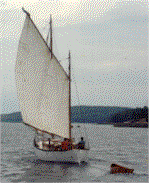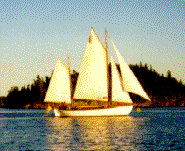 |
 |
 |
| Eric rafted with a friend | Broad reach | Ghosting along |
Eric
 |
 |
 |
| Eric rafted with a friend | Broad reach | Ghosting along |
Eric is a William Atkin design, and her plans are available from Atkin & Co., Box 3005, Noroton, CT 06820.
We are offering to build this famous vessel to any stage of construction, and in a number of different versions, at contract prices. Construction is either conventional plank on frame or Sheathed Strip.
Our interest in Eric stems from owning the original boat, bearing the name, which was built by Chute & Bixby in 1925. Over a number of years with the boat we have come to love and admire her. Though our own designs naturally better reflect our own thinking, there is no denying that she is a wonderful boat with superb traditional character. To this day she is many people's idea of the perfect boat, as evidenced by the reactions we witness everywhere we take her.
Countless sets of Eric plans have been sold by the Atkins since she was introduced, and hundreds of copies have been built, around the world. The most widely known example is the Westsail 32, which was modified from the Eric hull design and became very popular. Unfortunately only those Westsail owners who added additional ballast realized the true performance potential of the design.
Eric has a number of claims to fame. William Atkin derived her hull lines from the rugged Colin Archer Redningskoites, or sailing rescue vessels. These once served the treacherous Norwegian coast, following the bad weather and assisting vessels in distress, often working close to lee shores in confused seas and towing small vessels out of harm's way. To perform this work successfully, the boats had to have great buoyancy and stability, maneuverability in tight quarters, weatherliness, and no loss of control at either high or low speeds. That they did all this well was proven beyond a doubt, and we were fortunate to have had Oscar Tybying, one of the original boats, here in the yard for work. She still holds the record for lives saved by a single vessel. Having sailed her in some heavy weather we are not surprised, for heavy weather is this type's element. Small wonder that Atkin picked the Redningskoite to emulate at a time when people were just beginning to accept that small yachts could venture far offshore in safety. Eric is a slightly modified Redningskoite, reduced in size from approximately 47'to 32'.
There has always been debate as to whether the Redningskoite type is or is not the best for offshore work. Certainly the originals and the many Erics and similar boats have made countless successful voyages. Possibly they have made more than any other generalized type. She can certainly be defended as the most well-proven, or one of the most well-proven, offshore types. The Norwegian stern is commonly said to be the best for taking following seas offshore. It is probably over rated for that purpose. Many boats with large transoms have had no difficulty in these conditions. To us, the stern has two advantages. Because of the stern's tall, sharp shape and the outboard rudder, as the vessel travels faster (as in running off before a gale) there is more and more of the rudder in the water. This is due to the natural tendency of the stern wave to rise with the increase in speed. This should increase directional control when it is needed most. The reader is best qualified to judge whether these attributes are important to his uses, but they are positive characteristics. A nonperformance related advantage to the stern is that the underwater shape results in the engine and propeller being very far aft and horizontally mounted, making for more interior space, and a better lubricated engine. Because there are no overhanging quarters, it is also very easy to untangle lines from the prop.
It is our conviction that the type's reputation for speed would be excellent if new boats of the type were made with all of their ballast outside, had a higher percentage of the displacement in ballast, and were given the increased sail area which this would allow. Most people choose the Redningskoite type for heavy-weather performance, and for some reason think that requires a needlessly short rig. We would suggest plenty of light-air sail area and good reefing gear, in which case these boats will surprise a lot of people with the speeds they can attain.
Eric herself carries the original short gaff-ketch rig. As a result she is under canvassed in light air. However the rig is very beautiful. With her eight varnished spars, wide decks, pin rails, bulwarks and other traditional details, she is very much a small ship, full of character and comfort. She cannot be appreciated except in person, and we urge anyone with an interest to come see her. She is also available with a much larger gaff cutter rig, which should greatly increase light-air performance.
An Eric will be an excellent choice for those desiring a traditionally styled vessel of unique character, with proven heavy-weather capability, and excellent interior and deck space. Given the wide acceptance of the type, she should be a valuable and easily marketed asset, as well.
As this is being written, Eric is being rebuilt, to prepare her for her next 70 years. It is expected that she will be available for charter when that work is complete. Please inquire.
A complete ketch or cutter rigged Eric in Sheathed Strip and voyage equipped will probably run between $290,000 and $390,000 given today's appetite for "gear" and yachty teak decked varnished mahogany interior work, depending upon owner's options. Simple versions may run significantly less. We can also quote on partially completed vessels.
Readers may want to look at a recent picture of her having her bottom scrubbed and painted in spring of '98.